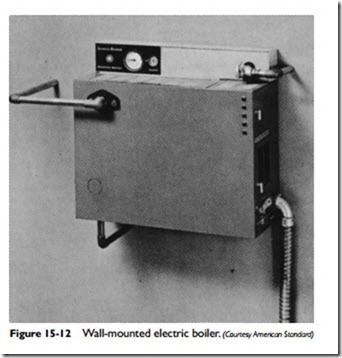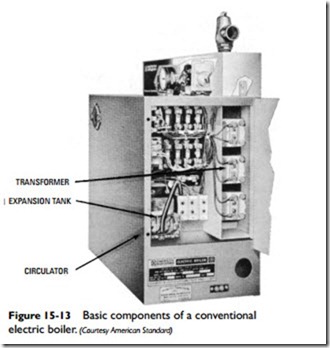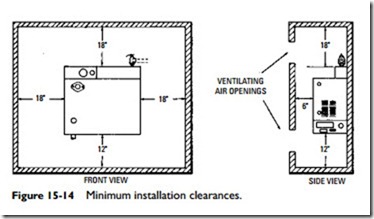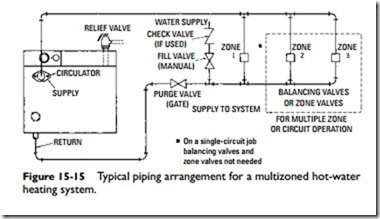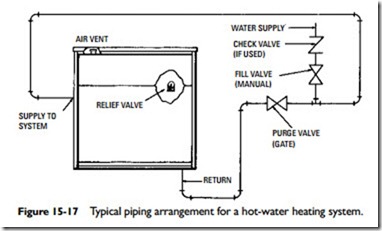Electric Boilers
Compact wall-mounted electric boilers are used in residential hotwater (hydronic) heating systems (Figure 15-12). Heat is generated by electric heating elements immersed in water housed in a water- proof cast-iron shell. Although small in size, these boilers are capable of generating as high as 90,000 Btu/h, enough heat for the average eight-room house.
The basic components of a conventional electric boiler are shown in Figure 15-13. An automatic air vent located above the cast-iron boiler shell is used for bleeding off trapped air from the water system. Safety devices include a water pressure-relief valve for reducing system pressure, an adjustable limit control that allows selection of maximum boiler water temperature for system design, and preset pressure controls to guarantee safe operation within the prescribed pressure range.
The limit control is an immersion device that shuts off the boiler if the temperature exceeds a predetermined setting. The preset pressure controls consist of a high-pressure switch and a preset safe-fill switch. The high-pressure switch is designed to deenergize the boiler if the pressure reaches 28 psi. This switch is reinforced by the relief valve, which is preset to relieve system pressure at 30 psi. The preset safe-fill switch prevents the electric heating elements from being energized unless pressure in the system is 4 psi. This
prevents any chance of the heating elements burning out should an attempt be made to operate the boiler dry.
The circulator, cast-iron boiler shell, and expansion are all enclosed within the outer steel jacket of the boiler. The electric heat- ing elements are mounted inside the ends of the boiler casting. A drain valve mounted below the boiler casting is designed for the connection of standard hose fittings.
All controls are prewired and mounted in place by the manufacturer. The only electrical connections that need to be made during the installation of the boiler are those to the main power supply and room thermostat.
The sequencing relay switch provides for an incremental loading on the electric service line. This reduces line voltage fluctuation and prevents power surge during energizing.
Minimum installation clearances for the boiler just described are shown in Figure 15-14. Two air openings of 108 in2 (6″ X 18″) each are required for closet installation.
A typical piping arrangement for a series-loop, hot-water heating system using an electric boiler of this capacity is shown in Figure 15-15. An outline of the procedure used for filling this sys- tem is as follows:
1. Close all zone valves except the one for the zone to be purged.
2. Open the boiler drain valve.
3. Open the fill valve.
4. Close the purge valve.
5. Vent air from the boiler by manually opening the relief valve.
6. Open the valve for the second zone to be purged and close the first.
7. After the second zone is purged, open the third zone valve and close the second.
8. Repeat the procedures described in Steps 6 and 7 for as many zones as are in the system.
9. When all zones have been purged, close the boiler drain cock.
10. When water appears at the relief valve, release the lever and allow the valve to close.
11. Continue filling until pressure gauge reads approximately 12 psi. Close fill valve.
12. Open purge valves.
Where multiple circuits are used without zone valves, balancing valves should be installed for balancing. These can be shut off to purge each circuit individually. For a single-loop system, no additional vents, valves, drains, or other accessories are required.
Smaller electric-fired boilers having outputs ranging from approximately 6000 to 20,000 Btu/h are available for individual apartment heating or for residential zoned heating through the use of several units. The basic components of one of these smaller boilers is shown in Figure 15-16. The piping arrangement for a series-loop heating
system using one of these boilers is illustrated in Figure 15-17. The procedure for filling the system is similar to the one just outlined except for the elimination of Steps 6 to 9.
